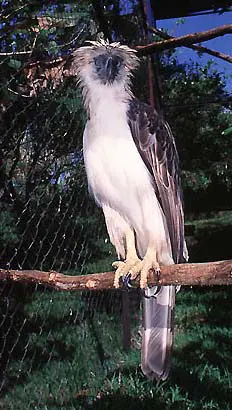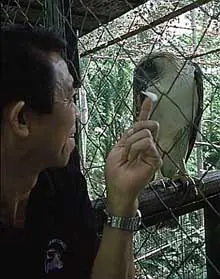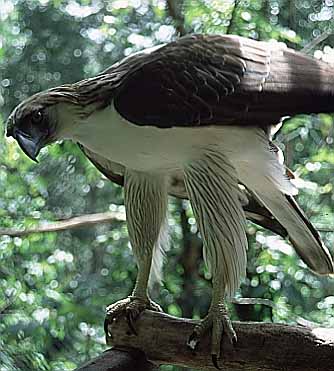One man’s perseverance offers hope to a critically endangered bird of prey
On a warm, sunny morning on the island of Mindanao in the southern Philippines, Domingo Tadena stands on a metal platform beside a roomy cage, watching a male Philippine eagle Pithecophaga jefferyi prepare to eat a young chicken. The massive, regal bird grasps the meal with a talon almost the size of Tadena’s outstretched hands. Hunching, it dips its head and rips a chunk of flesh from the dead chicken with its imposing, razor-sharp bill.
Domingo Tadena, a lean 55-year-old with a weather-creased face, is no stranger to this bird. Pag-Asa (Tagalog for “Hope”) is the first Philippine eagle to have been bred at the Philippine Eagle Centre, an eight-hectare encampment low in the foothills of Mount Apo.
The centre, which is dedicated to saving this critically endangered species, houses 23 eagles and chicks and employs 15 people. “The eagles are like family to me,” says Tadena, who heads the centre’s captive-breeding programme and calls the bird “king of the forest.”
The Magnificent Philippine Eagle

The description is apt. Ranking among the largest eagles and with a two-metre wingspan, the Philippine eagle is one of the world’s most magnificent birds of prey. America’s famed aviator Charles Lindbergh, who in 1969 helped establish a programme to protect it, called it the “noblest flier.”
Native to just four islands, the Philippine eagle has suffered an alarming decline in numbers in recent decades, due largely to hunting and deforestation. Most recent estimates have put the total number in the wild at 340 pairs, with Mindanao home to the largest remaining population. Tadena, who has devoted most of his working life to the Philippine eagle, hopes to ensure its survival by reintroducing captive-bred birds to the wild.
His love of birds can be traced to his childhood. Growing up on a farm near Davao, Mindanao’s largest city, he raised wild songbirds from nestlings, then released them. “I was fascinated by the swiftness and courage of even the smallest birds,” Tadena recalls. “When I took care of the nestlings, I hoped that they would follow me.”
With an inquiring mind but little formal education, he became a tractor driver when he left school, before becoming a carpenter.
It was only through happenstance that Tadena began working with eagles. In 1976, the Bureau of Forest Development decided to build a rehabilitation centre for confiscated Philippine eagles in Mount Apo National Park, 37 kilometres west of Davao. Tadena was originally hired as a carpenter. However, when the eagle keeper left, Tadena took his place.
Tadena experienced first-hand how dangerous his charges could be one day in 1981. As he entered a female bird’s cage, he heard a warning shout from a colleague. Instinctively he turned, raising his right hand to his face. The eagle swooped down – one of her talons ripped into his neck and cheek, the other fastened round his hand.
Tadena dropped to the ground. The talon in his face came free, but the other was locked on his hand, with a claw spearing his little finger through his protective glove. Colleagues, holding the eagle still, could not remove the claw using pliers. The centre’s staff finally tricked the eagle into releasing its grip by covering its eyes so it would open its claws ready to defend itself. “You’re lucky the talons missed your throat, or you might have been killed,” a doctor later told Tadena.

Captive breeding proved harder than Tadena had anticipated. He and colleagues found themselves hampered by poor equipment and lack of knowledge about the birds. “No-one knew how old males must be before they could breed, for example,” says Tadena.
And the eagles proved frustratingly anti-social. Twice, females introduced to potential mates killed the smaller males. When the eagles did mate, the eggs failed. In the programme’s first 14 years, just three fertile eggs were laid, and all the chicks died before hatching. There was widespread doubt that the eagles would ever breed in captivity.
The breeding programme was also threatened by civil war. During the 1980s, armed guerrillas started visiting the camp and helping themselves to the nine employees’ meagre rations.

One day in 1988, after seven government soldiers were killed in an ambush nearby, the army attacked the rebels. Shells exploded within 70 metres of the camp as terrified eagles struggled to escape their cages. Tadena helped with a nighttime escape, tying the birds’ feet together and swaddling them in cloth. They were loaded into a four-wheel-drive vehicle and taken to a site clear of the fighting in the foothills of Apo.
Funds were tight. Current Philippine Eagle Foundation chairman Manuel Garcia, then a local politician, persuaded a group of businessmen to support an adopt-an-eagle scheme, which helped keep the birds fed. The Frankfurt Zoological Society gave $20,000, which paid for staff quarters, a reception area and new cages.
But staff received only a tiny allowance. Tadena and up to five colleagues set up makeshift beds in an eagle cage while their quarters were being built.

Through all the hardship and tragedy, Tadena’s love of birds kept him going. “When I first started, it was just a job,” he says, “but as I learned more about the eagles, I realised how important it was to save them.”
And there were rays of hope. In 1990, Bill Burnham, president of the US-based Peregrine Fund, visited the centre. Impressed by Tadena and his team, Burnham wrote to the John D. and Catherine T. MacArthur Foundation, an American charity, which donated $130,000 to help purchase additional land and expand the facilities.
Burnham also arranged for Tadena and his colleague Eddie Juntilla to visit the Peregrine Fund’s headquarters in Boise, Idaho, where they spent four months caring for breeding birds of prey and looking after eggs until they hatched.

Back home, Tadena began to regard the eagle that once intimidated him as family. Using his growing understanding of the birds, he helped coax a female to lay. Working shifts with two colleagues, he watched over the egg 24 hours a day. As the egg developed, he sometimes took it out of the incubator and placed it on a bench. After a few minutes, the cooling chick inside trembled slightly, proving it was still alive.
Finally, on January 15, 1992, the chick was set to break from its shell. Tadena softly called “chuck, chuck, chuck,” like a mother eagle. Chirping, the chick began cracking the shell. With gloved hands, Tadena removed shell fragments as colleagues watched. At last the eaglet, covered in fluffy white down, emerged. There were shouts of “Yes!” and high-fives all round. Overcome with joy, Tadena placed the newborn Pag-Asa in a brooder, a plastic box that provided a controlled environment.

Thanks to the media coverage of the birth, visitors began arriving in their hundreds to see Pag-Asa. In 1995, then Philippines president Fidel Ramos declared the Philippine eagle the national bird. Donations started rolling in.
The eagle centre now attracts over 200,000 visitors a year. Education officers – and Tadena – explain to school groups that the Philippine eagle’s survival depends on protecting beleaguered rainforests. A newly opened information centre is spreading the conservation message. “The main aim is to protect the bird and its habitat,” says Tadena. One recent visitor, impressed, donated $11,600.
In recent years, Tadena and his team have had more successes. The 2000-01 breeding season, with two more births, was one of the best yet. In all, nine of the centre’s 23 eagles were bred on site.
Tadena still celebrates when eagles hatch, still weeps privately when eggs fail. He looks forward to the time when the centre will release a captive-bred eagle. Birds like Pag-Asa are too dependent on humans to be released, but if all goes well, perhaps the first to be set free will be one born this past winter.
” When Pag-Asa hatched, it was a great fulfilment,” Tadena says. “I hope to repeat those feelings when I see released birds in the wild with their own families.”
[This article appeared in the October 2002 Asian edition of Reader’s Digest. Reader’s Digest holds copyright in the text.]
